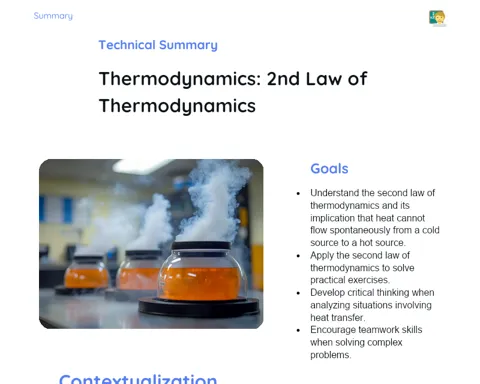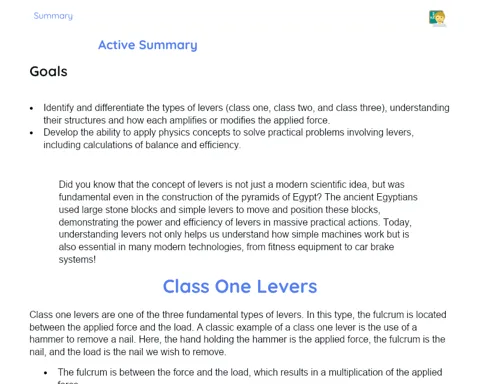Electricity: Electrical Circuits | Traditional Summary
Contextualization
Electricity is an essential part of our daily lives, present in virtually all modern human activities. From lighting our homes to powering computers and mobile devices, electricity is everywhere. Electric circuits are the systems that enable the controlled and safe use of electricity, allowing devices to function correctly and energy to be distributed efficiently. Understanding electric circuits is fundamental to grasping how electricity is utilized and how we can solve related problems.
Electric circuits consist of various components such as resistors, capacitors, power sources, and switches, each playing a specific role in controlling the flow of electric current. Electric current is the flow of electric charges through a conductor, driven by the potential difference, or voltage. Electric resistance, in turn, is the opposition to the flow of current in a material. Understanding these concepts is crucial for solving problems involving electric circuits, which is an important skill not only for studying physics but also for various practical applications in engineering and technology.
Electric Current
Electric current is the flow of electric charges through a conductor, usually a metal wire. These charges are typically electrons moving from a point of lower electric potential to a point of higher potential. The unit of measure for electric current is Ampere (A), representing the amount of charge that passes through a point in the circuit per second. The conventional direction of current is from the positive terminal to the negative terminal of the power source, although electrons actually flow in the opposite direction.
The magnitude of electric current in a circuit depends on two main factors: the potential difference (or voltage) applied to the circuit and the resistance offered by the circuit to the flow of electrons. According to Ohm's Law, current (I) equals voltage (V) divided by resistance (R): I = V/R. Therefore, for the same voltage, higher resistance results in lower current, and vice versa.
Direct current (DC) and alternating current (AC) are the two main types of electric current. In direct current, the flow of electrons is unidirectional, while in alternating current, the direction of electron flow reverses periodically. Direct current is commonly found in batteries, whereas alternating current is the standard form of electricity supplied by power grids to our homes and industries.
-
Flow of electric charges through a conductor.
-
Measured in Amperes (A).
-
Depends on the voltage and resistance of the circuit.
Potential Difference (pd) or Voltage
Potential difference, also known as voltage, is the force that drives electrons through a circuit. This potential difference is created by an energy source, such as a battery or an electrical outlet. The unit of measure for voltage is Volt (V). Voltage is essential for electric current to flow, as it provides the necessary energy to move electrons against the resistance of the circuit.
In practical terms, voltage can be compared to pressure in a water system. Just as pressure causes water to flow through a pipe, voltage causes electrons to flow through a conductor. Voltage can be constant, as in a battery (direct voltage), or vary periodically, as in electricity supplied by power grids (alternating voltage).
Voltage can be measured between two points in a circuit using a voltmeter. In a series circuit, the sum of the voltages across individual components equals the total voltage supplied by the source. In a parallel circuit, the voltage across all components is the same and equal to the source voltage.
-
Force that drives electrons through a circuit.
-
Measured in Volts (V).
-
Can be direct or alternating.
Electric Resistance
Electric resistance is the opposition to the flow of current in a material. It is caused by collisions between moving electrons and the atoms of the conductor. The unit of measure for resistance is Ohm (Ω). The resistance of a material depends on several factors, including its length, cross-sectional area, type of material, and temperature.
Ohm's Law describes the relationship between voltage (V), current (I), and resistance (R) in an electric circuit: V = IR. This means that for a constant current, voltage increases with resistance. In other words, more resistance requires more voltage to maintain the same current. Components such as resistors are used in circuits to control the amount of current flowing.
The total resistance in a circuit depends on the configuration of the resistors. In a series circuit, resistances add up. In a parallel circuit, the total resistance is lower than the smallest individual resistance, as there are more paths for the current to flow. Resistance is a crucial property in circuit design, allowing precise control of current and voltage.
-
Opposition to the flow of current in a material.
-
Measured in Ohms (Ω).
-
Described by Ohm's Law (V = IR).
Kirchhoff's Laws
Kirchhoff's Laws are fundamental for analyzing complex electric circuits. There are two main laws: Kirchhoff's Current Law (KCL) and Kirchhoff's Voltage Law (KVL). KCL states that the sum of currents entering a junction (joining point) equals the sum of currents leaving that junction. This is based on the principle of conservation of electric charge.
KVL, on the other hand, states that the sum of voltages in any closed loop of a circuit equals zero. This is based on the principle of conservation of energy. In a closed loop, the energy supplied by voltage sources equals the energy dissipated by resistors and other components.
These laws are essential for solving complex circuits where components are arranged in various series and parallel configurations. They allow for the determination of unknown currents and voltages at any part of the circuit. Applying Kirchhoff's Laws involves writing equations based on the laws and solving systems of linear equations.
-
Current Law: sum of currents entering and leaving a junction is equal.
-
Voltage Law: sum of voltages in a closed loop equals zero.
-
Essential for analyzing complex circuits.
To Remember
-
Electric Current: Flow of electric charges through a conductor.
-
Potential Difference (pd) or Voltage: Force that drives electrons through a circuit.
-
Electric Resistance: Opposition to the flow of current in a material.
-
Ohm's Law: Relationship between voltage, current, and resistance (V = IR).
-
Kirchhoff's Laws: Fundamental rules for analyzing complex electric circuits.
Conclusion
In this lesson, we explored the fundamental concepts of electric current, potential difference (voltage), and electric resistance, which are essential for understanding electric circuits. We discussed how these concepts interact and are applied in practice, using Ohm's Law and Kirchhoff's Laws to solve problems involving simple and complex electric circuits. Understanding these principles is crucial not only for studying physics but also for practical applications in engineering, technology, and everyday life.
Additionally, we analyzed different types of electric circuits, such as series and parallel circuits, and learned how to calculate the electrical quantities associated with these circuits. The ability to solve electric circuit problems is a valuable skill that can be applied in various areas, from maintaining electronic devices to designing complex electrical systems.
Finally, we reinforced the importance of Kirchhoff's Laws for analyzing complex electric circuits, allowing for precise determination of currents and voltages at any part of the circuit. This knowledge is fundamental for those seeking careers in technological and scientific fields where electricity plays a central role. We encourage students to continue exploring these concepts, applying them in practical situations, and deepening their knowledge about electricity and electric circuits.
Study Tips
-
Review examples and solved exercises in class, practicing the application of Ohm's Law and Kirchhoff's Laws in different types of electric circuits.
-
Use online electric circuit simulators to visualize circuit behavior and test different configurations of components.
-
Read additional chapters on electricity and electric circuits in physics textbooks or supplementary materials, seeking challenging exercises to deepen your understanding.



